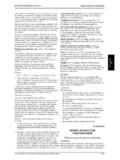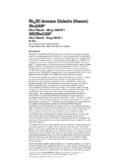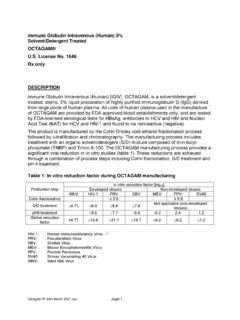Transcription of WHO RECOMMENDATIONS FOR THE …
1 ANNEX 4. WHO RECOMMENDATIONS FOR. THE production , control AND REGULATION OF. human plasma FOR fractionation . Adopted by the 56th meeting of the WHO Expert Committee on Biological Standardization, 24-28. October 2005. A definitive version of this document, which will differ from this version in editorial but not scientific detail, will be published in the WHO Technical Report Series. Page 2. TABLE OF CONTENTS. Page TABLE OF INTRODUCTION .. 1 INTERNATIONAL BIOLOGICAL REFERENCE PREPARATIONS .. 2 LIST OF ABBREVIATIONS AND DEFINITION USED .. 3 GENERAL Range of products made from human blood and plasma .. Composition of human Pathogens present in blood and 4 MEASURES TO EXCLUDE INFECTIOUS DONATIONS.
2 Appropriate selection of blood/ plasma Screening of blood/ plasma donations for infectious markers .. Screening tests .. Other NAT testing .. Test kits .. Quality control of screening .. Look- Epidemiological surveillance of donor population .. Strict adherence to Good Manufacturing Practices .. Post donation 5 production OF plasma FOR fractionation .. Methods used to obtain plasma for fractionation .. Recovered Apheresis plasma (source plasma ) .. Characteristics of plasma for fractionation .. plasma frozen within 24 hours of collection .. plasma frozen after 24 hours of collection .. plasma not meeting the requirement for fractionation .
3 Hyper-immune (antibody-specific) Page 3. Anti-D (anti-Rho) .. Anti-HBs .. Anti-tetanus .. Anti-varicella/zoster .. Anti-rabies .. Premises and devices for collection of plasma for Blood/ plasma collection process .. Labelling of collection bags .. Laboratory samples .. Volume of plasma per unit .. Secure holding and reconciliation .. Donor call back system .. Separation of plasma .. Intermediate storage and transport .. Impact of whole blood holding period .. Centrifugation of whole Impact of Freezing of plasma .. Holding time of plasma .. Freezing rate and freezing temperature .. Freezing conditions .. Impact of containers and equipment.
4 Validation of the freezing Storage of plasma .. Storage conditions and validation .. Page 4. Premises and equipment .. Segregation procedures .. Compliance with plasma fractionator Release of plasma for plasma release using electronic information systems .. Packaging of Transportation of Recall 6 QA SYSTEM AND GOOD MANUFACTURING Organisation and personnel .. Documentation system .. Premises and Validation Quality monitoring Virology safety testing .. Test equipment .. Assay performance validation .. Test interpretation and downloading .. Follow-up of Electronic information Storage and Change control system .. QA auditing .. Defect reporting Quality agreement between blood establishment and fractionator.
5 Blood/ plasma establishment audit and 7 REGULATORY control OF plasma FOR Role of national regulatory authority .. Establishment license and inspections .. Impact of Page 5. 8 AUTHORS .. 9 Annex 1: plasma products and clinical applications (adapted from [6].. 10 Annex 2: donor Information to Compliance with donor selection Positive identification of Questionnaire and Physical examination, Acceptance and deferral Physical Records and traceability .. Selection and exclusion Reinstatement .. Procedures .. 11 Annex 3: Donor immunization and plasmapheresis for specific 12 Annex 4: Contract plasma fractionation 13 Annex 5: Technical points to consider in establishing plasma specifications criteria and obligations between blood establishment and plasma fractionator.)
6 14 REFERENCES .. Page 6. INTRODUCTION. human plasma is a source of important medicinal products which are obtained by a combination of large-scale processing steps called fractionation . It is important that these products have an appropriate quality and safety profile. Recognizing the importance of the provision of safe blood, blood components and plasma derivatives, the 58th World Health Assembly in 2005 (WHA Resolution ) [1] supports "the full implementation of well-organized, nationally coordinated and sustainable blood programmes with appropriate regulatory systems" and stresses the role of "voluntary, non-remunerated blood donors from low-risk populations".
7 The provision of blood, blood components and plasma derivatives from voluntary, non remunerated donors should be the aim of all countries. The WHO requirements for the collection, processing, and quality control of blood, blood components, and plasma derivatives were published in 1994 [2]. Numerous developments have taken place since the time that document was published, requiring that updated both technical and regulation guidelines be prepared and made public at global level. The recently published WHO guidelines on viral inactivation and removal procedures [3] address the measures necessary to eliminate or reduce the risk from blood-borne viruses during processing of plasma into plasma derivatives.
8 The present RECOMMENDATIONS are intended to provide guidance on the production , control and regulation of human plasma for fractionation as a source material for plasma derived medicinal products. Such combination of information is necessary for the manufacture of safe plasma derivatives at global level, in both developed and developing countries. The current document, by bringing together experience and information, will serve as a guide to blood establishments in their implementation of appropriate procedures for the production and control of the starting plasma material, and will facilitate the provision of safe fractionated plasma products at national level.
9 It is intended to assist National (Medicine) Regulatory Authorities (NRA) in establishing the supervision necessary for assessment of the quality and safety of plasma for fractionation , either prepared locally or imported, and will therefore contribute to improved quality and safety of human plasma products worldwide. Manufacturers of plasma derivatives (fractionators) may use these guidelines when discussing the quality criteria of plasma for fractionation with representatives of blood establishments and the NRA. This guidance document addresses only human plasma sourced for the manufacture of plasma derivatives. plasma for clinical use is not discussed, nor is there any consideration of plasma from other species.
10 1 INTERNATIONAL BIOLOGICAL REFERENCE PREPARATIONS. Rapid technological developments in the measurement of biological activity of blood and blood products has required and still require the establishment of international biological reference materials. The full list of current reference materials relevant to blood products and related substances is available at the following WHO Web site address: The biological activity of blood products should be measured by comparison with the relevant International standard. Activity is usually expressed in International Units (IU), but may in some cases be expressed in SI units. Page 7. 2 LIST OF ABBREVIATIONS AND DEFINITION USED.
















